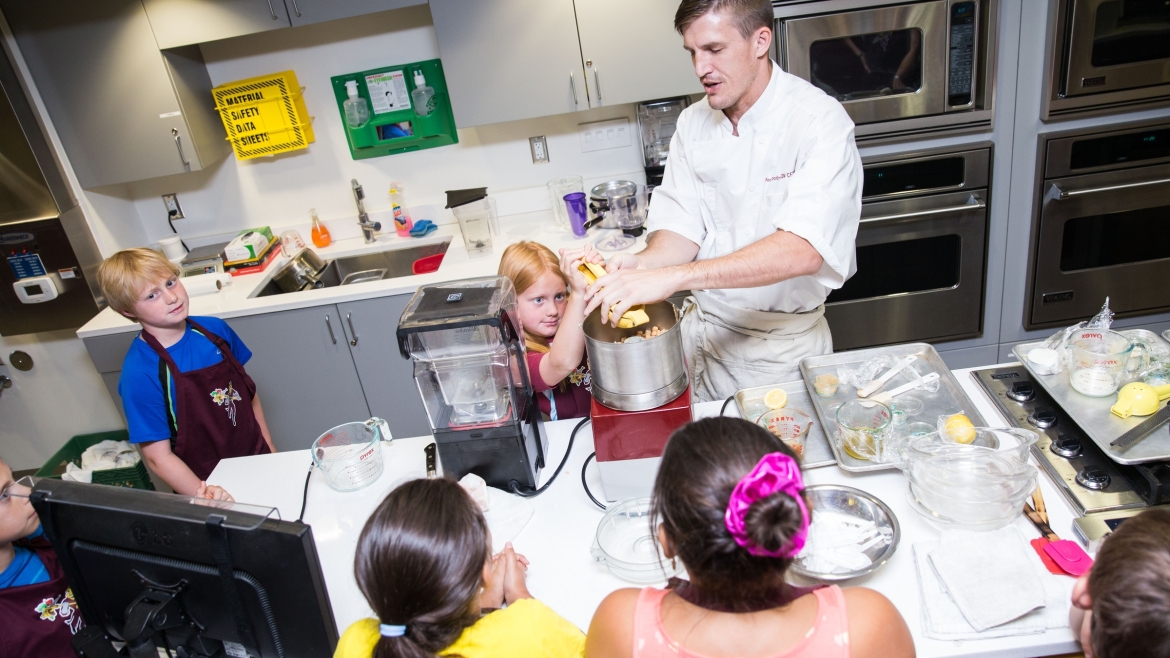It’s 10 a.m., and 14 campers ranging from 8 to 12 years old are noisily beginning their second activity of the day in their weeklong camp. But instead of learning how to pitch a tent or shoot a bow, these camp-goers are seated underneath the air-conditioned vents of ASU’s Health building, and their camp activity is to discover the solution to one of life’s biggest mysteries: Which one’s the salad fork?
The noise stops as the campers crowd around the demo table and learn about the minutiae of fine dining — like the difference between a bread plate and a dinner plate, the importance of passing salt and pepper in pairs, soup-eating techniques and how to cut meat into bite-size pieces. While it’s not your typical outdoor, build-a-fire type camp, Camp Crave is teaching these kids skills over an open flame that may be just as important in the modern age.
Camp Crave, hosted by the School of Nutrition and Health Promotion in the College of Health Solutions, emphasizes the importance of healthy living, including everything from sustainability to fine dining. Participants engage in 45 minutes of physical activity before heading to a classroom setting to learn about topics such as clean energy, solar cooking, table settings and nutrition.
Camp counselor Greg Nairn practices measuring with his students during Camp Crave at the College of Health Solutions in downtown Phoenix. Photo by Deanna Dent/ASU Now
“We partnered with the exercise and wellness program here in designing the curriculum,” said camp director Michelle Miller, a registered dietitian and coordinator of ASU’s Applied Practice in Nutrition program. “Recent studies have shown that exercise before class activity helps the campers stay focused during lessons.”
After a 45-minute classroom lesson on a chosen cooking or nutrition topic, each day ends in the more-than-5,000-square-foot ASU test kitchen in the Health South building, where the campers will create and eat meals including chicken picatta, rice pilaf and caprese salad.
“The children here are eating things they’ve never tried before,” said Gregory Nairn, a Camp Crave counselor and ASU senior majoring in health education. “They can serve meals that I didn’t know at their age. They’re eating chicken picatta. They’re eating caprese salad. I didn’t know what caprese salad was until I was stationed in Italy, 10 years ago.”
The camp is now 4 years old and hosts four one-week sessions for campers in grades 4-6 during June, with topics and featured cuisine rotating each year. Camp counselors are ASU nutrition students interning for course credit. But the biggest impact is seen on campers, who take the recipes they’ve learned back home to their families.
“[The dishes] are new to me,” said 12-year-old Jake Hirsch, a first-time Camp Crave participant. “In my family we don’t really go far out of our comfort zone. Sometimes we do Asian nights and sometimes we do different things, but we don’t venture off very far. So this was nice.”
ASU kitchen coordinator Kent Moody gets a little help squeezing a lemon from Gretchen Rostad during Camp Crave. Photo by Deanna Dent/ASU Now

If you’d like to try some fine-dining a la Camp Crave, here are two recipes courtesy of ASU chef Kent Moody.
Chicken Picatta (makes 2 servings)
Ingredients:
2 tablespoons olive oil
2 chicken breasts with skin
½ cup of seasoned flour (¼ cup flour, bleached or whole wheat; 1 tablespoon kosher salt; 1 teaspoon black pepper)
4 cloves fresh garlic
¼ cup diced tomatoes
¼ cup diced artichokes
¼ cup sliced mushrooms
1 cup chicken stock
Juice from 1 lemon
1 tablespoon capers, with a little juice
2 sprigs fresh parsley
2 sprigs fresh basil
1 tablespoon grated Parmesan
Salt and pepper to taste
Directions:
• Heat oil in a medium sauté pan and over high heat, until the oil is nice and hot.
• Dredge the chicken breast (dip thoroughly) in the seasoned flour. Shake off any extra flour and place skin side down in the hot pan. Cook until the skin is nice and golden brown and flip over.
• Add the garlic, tomatoes, artichokes and mushrooms and cook until the garlic starts to brown.
• Add the chicken stock, lemon juice and capers and stir until sauce is smooth. Place a lid over the dish and reduce the heat to medium high. Allow the chicken breast to cook thoroughly and the sauce to thicken.
• Season with the fresh herbs, cheese and salt and pepper. Serve with rice pilaf if desired.
Rice Pilaf (makes 4-5 servings)
Ingredients:
2 cups uncooked brown rice (not “minute” rice)
¼ cup quinoa
4½ cups chicken stock
2 tablespoons butter
1 tablespoon kosher salt
1 teaspoon black pepper
Directions:
• Preheat oven to 400 degrees.
• Place all ingredients in a large pot and cover tightly with a lid or aluminum foil.
• Place in oven and allow to cook for 45 minutes.
Top photo: Eliana Aguila (left) and Milagro Tellez test their results after learning how to make a spicy roasted red pepper aioli during Camp Crave at the College of Health Solutions in downtown Phoenix. Photo by Deanna Dent/ASU Now
More Health and medicine

New study seeks to combat national kidney shortage, improve availability for organ transplants
Chronic kidney disease affects one in seven adults in the United States. For two in 1,000 Americans, this disease will advance to kidney failure.End-stage renal failure has two primary…

New initiative aims to make nursing degrees more accessible
Isabella Koklys is graduating in December, so she won’t be one of the students using the Edson College of Nursing and Health Innovation's mobile simulation unit that was launched Wednesday at Arizona…

Reducing waste in medical settings
Health care saves lives, but at what cost? Current health care practices might be creating a large carbon footprint, according to ASU Online student Dr. Michele Domico, who says a healthier…



